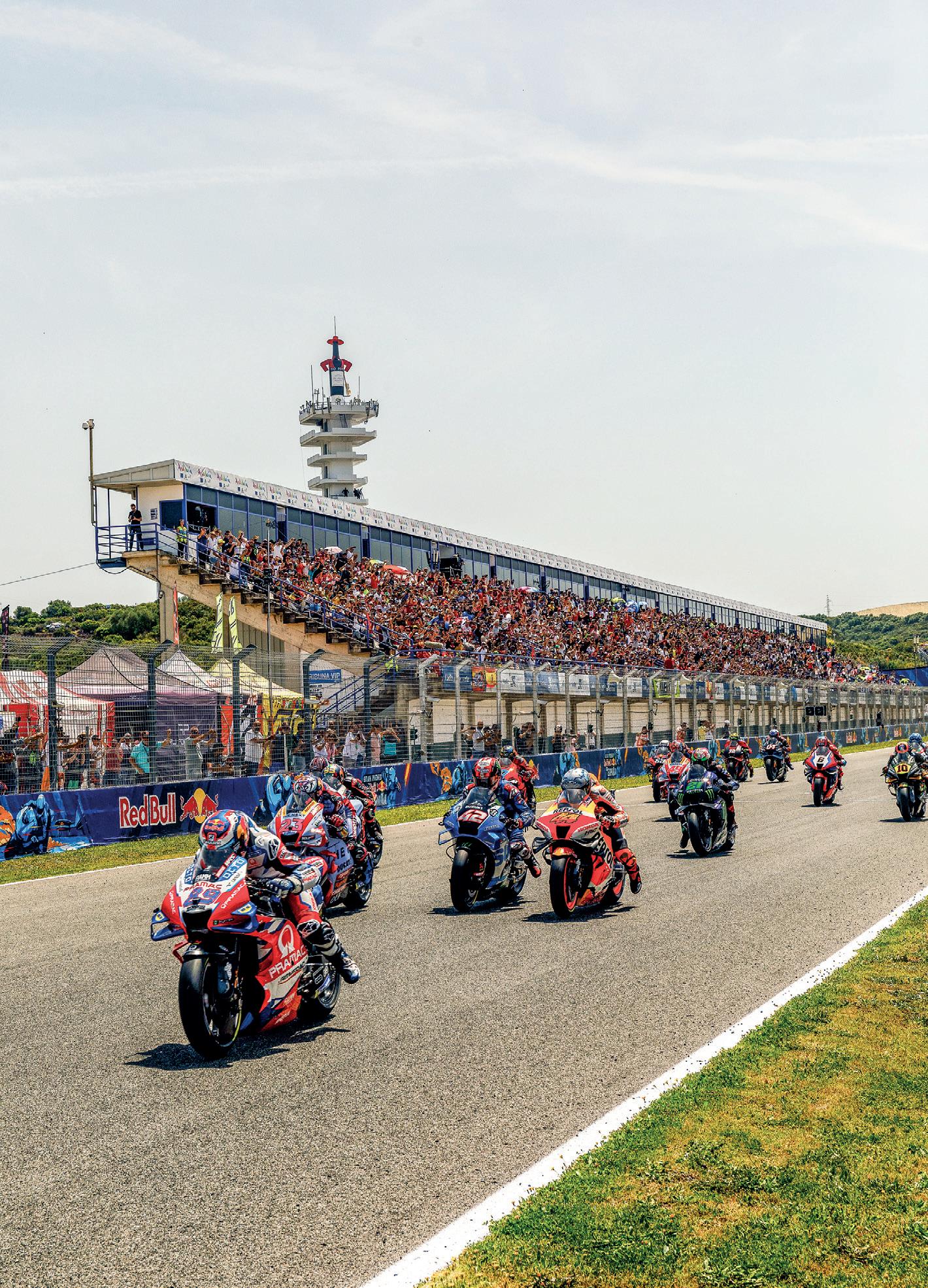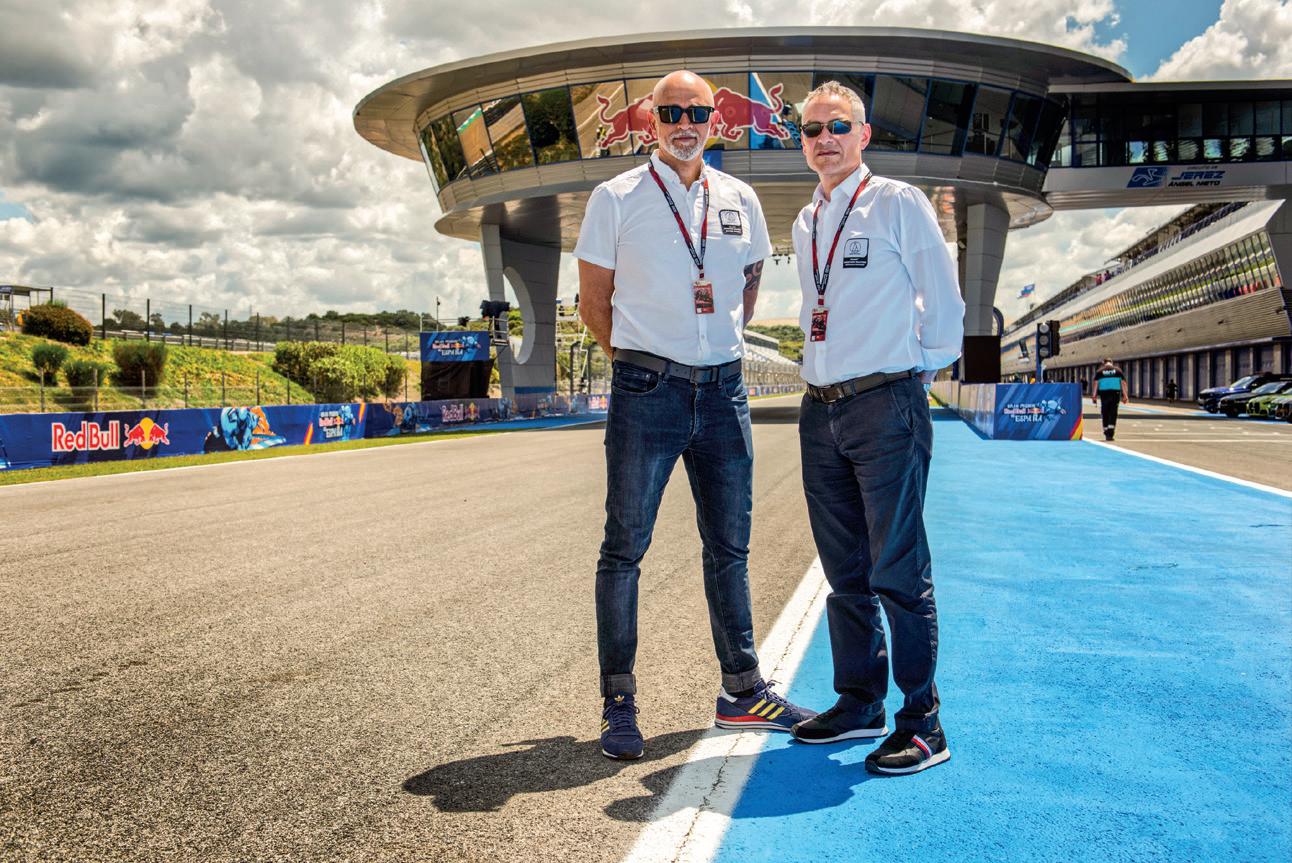
7 minute read
MotoGP
Live from Jerez: Audio-Technica and Dorna sounding ready for another MotoGP in the Spanish sun
BY MICHAEL BURNS
Advertisement
FIRST PUBLISHED 29 APRIL 2022
It is a hot weekend in Jerez de la Frontera and the action is about to get hotter as the Spanish Grand Prix takes place in the sunshine of Andalucía.
The Circuito de Jerez-Angel Nieto was built in 1986 and has been a fixture on the MotoGP calendar since its first Grand Prix a year later. Capturing the action as ever is Dorna Sports, the exclusive commercial and television rights holder and organiser of the championship — properly known as the FIM World Championship Grand Prix — since 1991.
Back to normality
It’s the first season to get back to anything like normality for the championship, which has travelled straight from Portimão in Portugal down to Jerez for round six of the 2022 season. It is also back to normal for Audio-Technica, the official Microphone Services Solution Provider to MotoGP, which has just signed a second consecutive threeyear relationship with Dorna.
This deal covers all the microphones and headphones in use across the MotoGP environment, not just for trackside sound, but also covering press conference rooms, interviews and ENG, as well as the microphones inside the broadcast truck.
More than 300 channels come into the audio control room (ACR), to be managed live on each race for the international feed by a team headed up by Pep Mendoza, sound manager for MotoGP. The whole audio set up goes on a global tour with the rest of the MotoGP ‘circus’, travelling for nine months of the year covering around 22 back-to-back races.
Trusting partnership
Speaking to SVG Europe in the paddock at Circuito de Jerez, Audio-Tec hnica Europe CEO Robert Morgan-Males and MotoGP project manager Rodrigo Thomaz were keenly anticipating how the race would put the company’s microphones and headphones through their paces.
“We have had experience in sports broadcasting for many years in terms of a microphone transducer technology with the world’s largest sporting event since 1996,” said Morgan-Males. “But getting close to a regular event with MotoGP you’re in a much different environment, because you’re constantly on the move, the circus goes on for the whole year, and you’re a team.”
Morgan-Males says Dorna is open to taking prototypes into the MotoGP environment. “Dorna is at the pinnacle of sports innovation. They will actually take a prototype live there and then, so we’re getting instant feedback,” he says. “Also, being the exclusive microphone solutions provider helps us across the broadcast industry as a whole, as people know the premium quality that’s coming out of MotoGP.”
Thomaz works alongside Mendoza, and Sergi Sendra i Vives, head of global technology at Dorna Sports. “I’m here as a project manager to interface and glue this together,” says Thomaz. “Pep is a super-capable, experienced sound engineer. He knows what he needs to achieve. My role is to allow him to achieve that, to come up with solutions and give him the right inspiration [from the Audio-Technica range]. He might be looking for a product that he doesn’t know exists. We have a huge catalogue that we can dig from, but we are also working with some products that we are modifying specifically for MotoGP.”
One such product, which has undergone extensive testing over the past three MotoGP seasons is AudioTechnica’s 8.0 Microphone Concept. Also known as the
BP3600, this ultimately forms part of the central sound source for a remote production workflow to be located in Dorna Sports’ facility in Barcelona, which includes a custom-built 7.1.4/5.1.4 dedicated audio control room to mix immersive audio received from the track in real time.
“We’ve used the BP3600 microphones at major winter and summer sporting events in the past four years,” says Thomaz. “However, MotoGP had a 3D-printed prototype two years prior to that. So they were beta testing it for us and helping us understand the microphone beforehand in a more brutal environment.”
Looking forward
“It’s exciting to be here,” says Morgan-Males. “It’s been a strange past three years, we haven’t been able to interact as much as we would normally do with the guys here because of the COVID protocols. Although there are obviously still COVID security measures in place, it’s slightly different, but certainly, it feels like we’re getting back to normal. We’re in a second contract with Dorna, which is a great relationship. We survived the pandemic together. They’ve been able to continue to deliver great content, and we’re helping them enhance that content. So, I’m incredibly excited to be back.”
Audio-Technica takes the MotoGP challenge onboard at Jerez
In the audio control room (ACR) in the Dorna Sports compound at the Circuito de JerezAngel Nieto in Andalucía, Pep Mendoza, sound manager for host broadcaster Dorna Sports, sits ready at the Lawo mc²56 mixing console, attentive to the requests coming through his Audio-Technica headphones from the race director in the international programme feed (IPF) gallery across the compound.
The desk inputs, set for Audio Follow Video, move in time with the main feed; there would be no way anyone could handle the fast switching of the inputs from so many sources. Suddenly there is a crash, Mendoza reaches over and smoothly adjusts his faders, and the pebbly sound of the bike and (safe) rider skidding across the gravel fills the room.
This total immersion is aided by the clever placement of hundreds of microphones around the track and onboard the bikes, all supplied by Audio-Technica.
Rodrigo Thomaz is the Audio-Technica Europe project manager for MotoGP. “The most obvious challenge is the sheer volume that is created by the bikes and the environment itself,” he says. “You may think that if things are loud, it’s easy to capture. But with a high level of contamination from the environment, it’s difficult to focus on anything. You need to find microphones capable of working under the extremely high sound pressure levels (SPL) of the bikes, but at the same time, perform in delivering high quality and detail.”
“We had to take time to decipher it,” he adds. “We created solutions for each portion of track, rather than approach MotoGP as one thing.”
It is not a small task; on the weekend we were at Jerez, there were 22 track feed cameras alone, including a jimmy jib, ground cams, bridge cams and several fixed and tripod positions.
Chasing onboard sound
MotoGP has the highest number of cameras in a single sports broadcast, mainly because there are four onboard cameras for each bike. “If you have a camera there is a need to have audio,” says Thomaz. “We are not talking
about a static mic, these are objects moving at 350km per hour.” Audio-Technica has been working on a modified version of one of its lapel mics, the BP899, specifically for MotoGP bikes. On the track at Jerez for the last race weekend there were three new Audio-Technica BP3600 microphones able to capture high-end detail, the different crowd noise and atmospheres at the various tracks, as well as tolerate working with high SPLs. A high number of BP28 largediaphragm shotgun mics are also mounted on cameras very close to corners or situated on the main straights. Audio Technica Europe’s CEO Robert Morgan-Males and MotoGP The long straights, particularly the starting Project Manager Rodrigo Thomaz on the track at Jerez grid, are covered by the BP4025 stereo mic. But Dorna has paired this with the BP40, Audio-Technica’s largest dynamic diaphragm microphone. “They put on a filter so only the low-end sound is processed in this microphone, leaving the BP4025 to concentrate on lowmids, mids and high frequencies. Especially at the start, when 20 bikes are roaring together, it gets very loud. It’s too loud for human hearing. We need a mic that can go beyond that so that when the viewer is at home and has a surround system, we can put that low end back into the listening environment without distorting everything.” Dorna uses a lot of interesting camera angles, deploying jibs to get both really low and also overhead shots. These are matched by the BP4029, a very short stereo shotgun mic. “It gives a very nice spread from left to right but again it must be able to tolerate the highest SPL,” says Thomaz. “We also use them on the shoulder-mounted ENG cameras. As the operators navigate inside the boxes; they need a stereo image to match a wide-angle lens.” Some of these boxes are also wired for sound, in that a few have a U851R boundary microphone positioned high on the wall. Again it’s a versatile mic with high SPL, which can capture the sound of each box at the pit lane as the bikes come and go. “The pit lane is the heart and soul of MotoGP, it’s where all the action happens,” says Thomaz. “Now you can hear and feel what they feel and hear as if you were there.”











